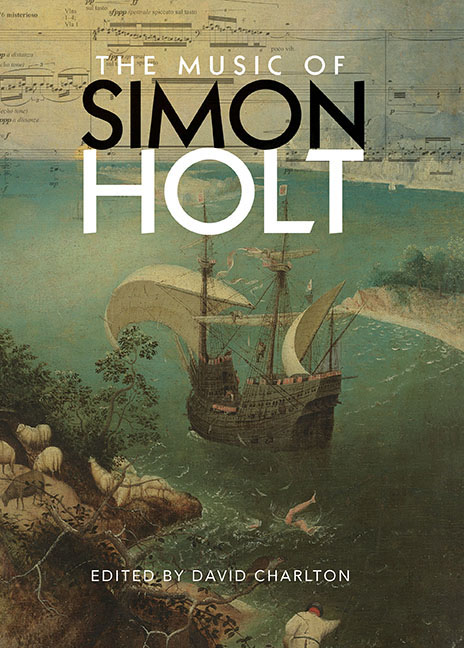Book contents
- Frontmatter
- Contents
- Figures and Tables
- Contributors
- Preface and Acknowledgements
- Abbreviations, with a note on recordings and scores
- Introduction Memories of Magical Moonlight: Simon Holt's years as a composition student
- 1 Duende y Duelos: The Andalusian spirit in the Lorca settings
- 2 An Interplay of Passion and Spirit: The Nightingale's to Blame
- 3 Images in Sound: Movement, harmony and colour in the early music
- 4 Myth and Narrative in 3 for Icarus
- 5 Sound, Sense and Syntax: The Emily Dickinson settings
- 6 Piano Music
- 7 Redefining the Cello's Voice: Musical agency in feet of clay
- 8 Performance and Reflections: Holt's music for oboe and cor anglais
- 9 Shaking the Bars: The Yellow Wallpaper
- 10 Listening to the River's Roar: Stance, texture and space in the concertos
- 11 Orchestral Works in Performance
- 12 Oblique Themes and Still Centres: A conversation between
- 13 Sketching and Idea-Gathering
- 14 Art, Conceptualism and Politics in Holt's music
- Appendix A Overview and Catalogue of Pieces
- Appendix B Texts by Simon Holt for Raju Raghuvanshi is a ghost and The Legend of Melusine
- Bibliography
- Index of pieces by Simon Holt
- General index
9 - Shaking the Bars: The Yellow Wallpaper
Published online by Cambridge University Press: 01 September 2018
- Frontmatter
- Contents
- Figures and Tables
- Contributors
- Preface and Acknowledgements
- Abbreviations, with a note on recordings and scores
- Introduction Memories of Magical Moonlight: Simon Holt's years as a composition student
- 1 Duende y Duelos: The Andalusian spirit in the Lorca settings
- 2 An Interplay of Passion and Spirit: The Nightingale's to Blame
- 3 Images in Sound: Movement, harmony and colour in the early music
- 4 Myth and Narrative in 3 for Icarus
- 5 Sound, Sense and Syntax: The Emily Dickinson settings
- 6 Piano Music
- 7 Redefining the Cello's Voice: Musical agency in feet of clay
- 8 Performance and Reflections: Holt's music for oboe and cor anglais
- 9 Shaking the Bars: The Yellow Wallpaper
- 10 Listening to the River's Roar: Stance, texture and space in the concertos
- 11 Orchestral Works in Performance
- 12 Oblique Themes and Still Centres: A conversation between
- 13 Sketching and Idea-Gathering
- 14 Art, Conceptualism and Politics in Holt's music
- Appendix A Overview and Catalogue of Pieces
- Appendix B Texts by Simon Holt for Raju Raghuvanshi is a ghost and The Legend of Melusine
- Bibliography
- Index of pieces by Simon Holt
- General index
Summary
Every kind of creature is developed by the exercise of its functions. If denied the exercise of its functions, it can not develop in the fullest degree.
SUCH AWARENESS of the developmental needs of living beings may seem basic to a twenty-first-century observer, but it was a radical concept in 1890s America. Nonetheless, the expected ‘proper’ functions of women, and their resulting status, were a matter of increasingly fervent challenge by campaigners for social equality. This characteristically blunt declaration formed part of an appeal for women's suffrage by Charlotte Perkins Gilman, four years after the publication of her semi-autobiographical text, ‘The Yellow Wall-paper’, in 1892. More famous in her lifetime as a public intellectual than as a fiction writer, Gilman wrote over 200 short stories: ‘The Yellow Wall-paper’ has become a classic of the feminist literary canon. It relates the descent into madness of an unnamed Woman who is suffering what today would be diagnosed as postnatal psychosis. Gilman herself experienced bouts of depression throughout her life and underwent a ‘rest cure’ in 1877, two years following the birth of her daughter, Katharine Beecher Stetson. During this period she was forbidden all mental and creative activity, and later wrote that the effect of such enforced constraint was to push her ‘so near the borderline of utter mental ruin that I could see over’.
Simon Holt first came across ‘The Yellow Wall-paper’ in 1981 and found it compelling. In his words, ‘the way the story is told is utterly uncompromising and, considering when it was written, the courage of it is extraordinary’. He remained ‘haunted’ by the tale, but composing a musical response to it proved challenging. Thirty years later, Holt was commissioned to write his concluding piece as Composer-in-Association for the BBC National Orchestra of Wales and ‘felt that this was finally the time to deal with it’.
Holt's composition (H 67) is a thirty-minute scena scored for solo soprano, six female voices and a reduced orchestra. Intended for the concert platform, it is a dramatic work allied to secular cantata and operatic traditions, but it belongs in neither category. Nor is it a song cycle, but rather a through-composed psychological study comprising nine short scenes, allied to a music-theatre tradition exemplified by Peter Maxwell Davies's Eight Songs for a Mad King.
- Type
- Chapter
- Information
- The Music of Simon Holt , pp. 178 - 193Publisher: Boydell & BrewerPrint publication year: 2017

